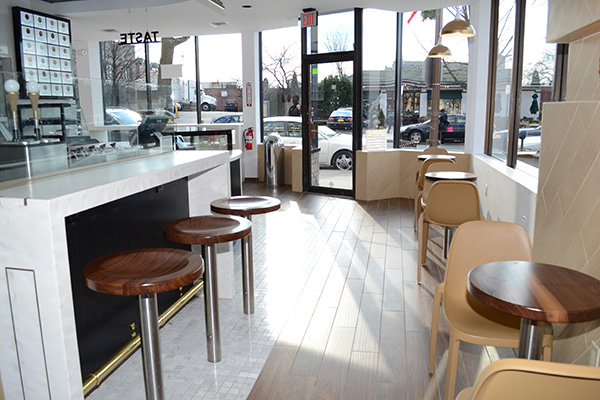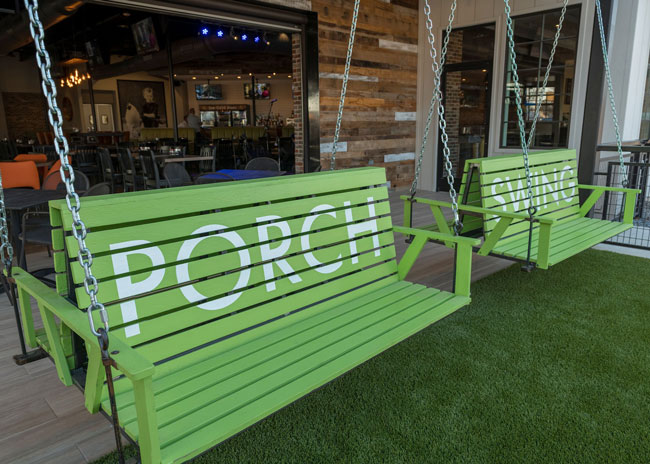With COVID-19 far less likely to spread from person to person in open-air spaces than indoors, local governments allowed restaurants to occupy public areas, giving them a chance to survive during the health crisis that began in 2020. Outdoor dining spaces sprouted on sidewalks, streets, parking lots and any other nook that could support them. Indeed, for many establishments, outdoor dining was a life preserver, enabling them to continue on-site service even when indoor occupancy was restricted.
With pandemic fears receding, it turns out that patrons still love al fresco dining. This is true in all regions of the country and under many weather conditions. “Outdoor dining is not going away, even in a post-COVID era,” says Joshua Zinder, managing partner with design firm JZA+D. He and other designers say new concepts almost always include an outdoor component that is integral to the plan, not an afterthought.
If the intent is for year-round or multi-season outdoor dining, outdoor spaces must account for the local climate to make guests comfortable in all kinds of weather. While some establishments close outdoor spaces in winter, others create areas that are comfortable in cold weather. Likewise, designers make spaces suitable for the hottest days of summer.
In addition to thermal comfort, there are numerous aesthetic and functional considerations when choosing materials, furniture, lighting and decor for outdoor venues. Designers say that when rolling out outdoor dining spaces, owners should not just place a few tables under umbrellas and call it a day. For best results, pay attention to all the design elements in outside spaces as you would indoors.
Assessing Space Options
Planning begins with assessing the space available for outdoor seating. When the use of public spaces such as a sidewalk or municipal parking lot is desired, owners must secure permission from local authorities and adhere to relevant regulations. dLeña, a Washington, D.C., Mexican restaurant, hit the jackpot on available public space. The restaurant, carved out of the lower levels of four historic townhomes, was fortuitously located along an unusually wide, bustling 35-foot sidewalk punctuated with attractive city-owned stone planters. It was a setting made to order for outdoor dining.
During initial business planning before COVID, the establishment’s owners had modest ambitions for outdoor dining, planning to place a few tables along a 6-foot strip adjacent to the building. Then, the pandemic-induced outdoor dining boom changed their calculus. “Once they realized so many people wanted to sit there, they submitted an application for a permanent structure,” says Peter Max Bowden, principal, PETERMAX Co. The city, having realized the benefits of outdoor dining, readily approved the request. “Outdoor dining adds so much to the streetscape and energy of the city,” Bowden notes. Today, dLeña’s outdoor dining patio, enclosed by a permanent glass and metal structure, seats 40 to 50 guests, forming a sizable percentage of the restaurant’s total seating capacity of about 175.
Few restaurants have the option to expand into as large of a public space as dLeña’s, though. Most sidewalks are narrower, limiting the amount of space for tables. For city officials, ease of pedestrian traffic flow is paramount with minimum widths for walking lanes. “If you have a 10-foot-wide sidewalk, you would typically be able to use up to half of that width,” says Kevin Wienke, associate and multi-unit studio leader, DP3 Architects, Ltd. Of course, this varies by municipality.
Shading the Sun
When you have multiple options for spaces to locate outdoor dining, it is usually better to choose areas on the north and/or east sides of the building, Wienke advises. This positioning strategy takes advantage of the existing structure to provide shade, which is critical in the late afternoons and early evenings. This blocks blinding sunlight as the sun sets and creates a cooler environment in the hottest weather. You might also be able to take advantage of natural landscaping if you are lucky enough to have trees shading your space. Otherwise, you have multiple choices for adding artificial shade.
Umbrellas are the cheapest option. Coming in multiple sizes and colors, they must be secured with a heavy base to keep them from tipping in the wind. Shade sails, fabric coverings larger than umbrellas, provide more shade, but they can catch the wind like boat sails so they must be securely fastened. The bigger they are, the more wind force they are subjected to, so larger shades need to be anchored with more points of fastening.
Sometimes shade sails can be secured to the building using eye bolts. They can also be tied to posts driven into the ground and via tie lines to any sufficiently anchored structure such as a tree or lamp post. Sail shades can be layered to create large areas of shade. Roof overhangs, awnings, canopies and trellises are more permanent shade options, costing more than umbrellas or shade sails but able to cover a larger area.
While awnings and canopies generally stand up to breezes well, unusually high winds can threaten them. “Having the ability to retract will extend their life,” Zinder points out. Even when awnings are securely fastened to a building, he says, strong winds can damage them. He recalls one storm in Princeton,
N.J., where his firm is based, that damaged a half dozen awnings. Had the structures been retracted, they likely would have weathered that storm.
Winter Shelters
A high-end, permanent structure such as dLeña’s metal and glass room, provides maximum comfort in cold weather, but this option comes at the highest cost. Manufacturers supply these enclosures in semi-customizable configurations. They are typically made from light-gauge aluminum frames with limited color choices, typically white or black. These products can be configured for just about any size space and are fairly easy to assemble on-site, Bowden says.
Fabric and plastic tent-like enclosures are another popular choice. Though less durable than a hard structure, they can enable year-round outdoor dining in many climates, providing shade in summer and an enclosed space that retains heat from heating elements in winter when doors, flaps and windows are closed.
During the height of the pandemic, another option — plastic pods to enclose individual tables — emerged. These products had the advantage of isolating the airspace of parties from each other, restricting the spread of disease. And when equipped with a portable heater, the enclosures were comfortable spaces for diners in cold weather climates like New York City. But as the pandemic waned, they lost favor. “People seem to be less interested in them now,” Zinder says. “Cleaning and servicing them is more difficult, and customers began to perceive that they hadn’t been cleaned. We have a number of clients who used them but have either eliminated them or packed them up and stored them away.”
Heating Choices
Owners have a few options for heating outdoor spaces. Portable propane-powered heaters can be placed near tables in an open-air environment to take the edge out of the chill of a cool night. These units can also throw enough heat into enclosed spaces to make outdoor patios in below-freezing temperatures comfortable. Manufacturers provide specs and formulas that help designers specify how many heaters are needed and how widely they should be spaced to provide optimal comfort for occupants. “If the space is fully enclosed, you need a fan or hood that can pull the exhaust out,” Wienke emphasizes.
Infrared natural gas heaters are another option if you have a connection to a gas utility. These are generally less expensive to use than propane models but are fixed in place. It’s typically possible to connect these units to your existing gas line, Wienke says, and permitting in such cases is fairly straightforward. Fixed electric space heaters can work where gas lines are unavailable, and this option does not require ventilation. At dLeña, electric units are fastened to the ceiling and are positioned at different angles for better coverage of the space.
For cooling, fans — overhead or side-facing — are the most common added elements. In rare cases, air-conditioning units are employed, but only when the space is fully enclosed, acting more like a dining room annex than an open-air space. Where summer heat is extreme, such as in Las Vegas, restaurants occasionally place misters away from tables so that patrons can have a quick spray of water to cool off without being constantly sprinkled upon.
Aesthetic Pizzaz
Although choice of materials, furniture and fixtures are limited in spaces open to the elements due to durability concerns, designers still have many options to dress up dining spaces. “My approach is always to bring as much design from the interior to the outside as possible and maintain the aesthetics of the concept,” Bowden says. At dLeña, his choices were guided by the desire to use natural, rustic earth tones.
Bowden caught a break on flooring as the wide, city-owned sidewalk already had attractive natural stone pavers in place with tones in sync with the design motif. Other popular options for outdoor flooring are stained concrete and wood-framed or composite decks. Occasionally, decomposed granite,
a long-lasting, inexpensive option, fits the bill.
Tabletops are a medium to make design punctuations, but material choices outdoors are limited due to durability concerns. Bowden has used teak, a durable wood, on some projects, but this material requires refinishing every couple of years. Composite faux wood, which comes in multiple natural-looking finishes, is more common, he says. Metal, also quite durable, is a common table material but is more limiting aesthetically, with paint the main option for finishing. Faux rattan, composed of composite material, is less common but emulates a natural material, adding warmth to the overall look. Whatever the material chosen for tables and chairs, stackability is a plus, making furniture easier to store.
Lounge-like furniture has become more popular in recent years, Zinder says, as restaurants dedicate space for guests to relax with cocktails and appetizers. This type of seating is typically enhanced with cushions wrapped in outdoor fabric. Providing shade over these areas will help extend the life of the fabric as sunlight tends to bleach and degrade them over time. Some restaurants enhance the outdoor lounge experience with a firepit feature fueled by wood or natural gas.
Lighting elements enrich the ambiance of outdoor spaces after dark. Overhead lights can be affixed to awnings, umbrellas, trellises and permanent roof structures. Some models are powered by rechargeable batteries and come with clip-on holders. String lights and sconces that can be attached to walls and posts provide side lighting. Outdoor models are available to backlight decorative features such as shelving and storage cabinets. There are also the old standbys of candles on each table, with the modern option of battery-powered LED models available.
Outdoor spaces are the perfect setting for lush arrangements of plants and flowers. dLeña, for example, takes full advantage of this with numerous planters defining the edge of the dining area, playing off the larger city-owned planters nearby. Be prepared to dedicate appropriate time and effort to maintain these features, though, as neglected plants are very unattractive and project an image of a place that is not paying sufficient attention to operational details.
Despite the challenges to designing, constructing and maintaining an appealing outdoor dining space, for many restaurateurs, it’s well worth their while to do so. In the current market, many patrons crave al fresco dining as much as they crave their favorite dishes. Some may choose where to spend their hard-earned disposable income based on which establishments have the best outdoor dining venues. Don’t take this trend lightly.



